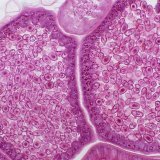Fungal infection of the pharynx and esophagus

The cause of fungal infection is often the candida fungus, which, in addition to causing many diseases, can still cause cancer.
The family of fungi is very extensive and they live in different living organisms, man is no exception. In humans, as a normal flora, there are more than 300 different fungal organisms. They are found on the skin, in the mouth, esophagus, intestines and vagina. They are justified there, thanks to a warm and humid environment.
Fungal infection in humans.
Scientists of pathogenetics, after a series of studies, came to the conclusion that a healthy person does not have a fungal infection. Conversely, fungi fulfill their specific ecological role.
It does not follow that fungi are not aggressive at all, but their actions are directed against other fungi. Since they and in general throughout the animal kingdom there is a fierce competition for the habitat and food. And it does not depend on the type of fungus, any of them produces antibiotics in order to suppress competitors. Thanks to this, the body maintains a balance between all fungi.
One of the varieties of fungus that inhabits a person is a candidate. Preferably, the habitat will have the gastrointestinal tract. Fungus settles on its entire length - from the mouth to the direct intestine. Also, the fungus lives in the genitourinary system and on the female genitalia. Fungus lives on any human body, regardless of age and sex. And this interaction begins early in some people - from birth. The baby acquires a fungus or in the process of giving birth, if the mother had them in the reproductive canal. Or later, when his mother kisses and irones him. Fungus candida lives on the skin of the hands and in the mouth. By the half-year almost one hundred percent of children already have these fungi.
Our body regulates the degree of reproduction of these fungi. And, by the way, the skin and external senses are a bad environment for excessive reproduction of candidiasis. For them, this is an extremely dry environment. In fact, a human immune system protects against unwanted spread of fungi.
Fungal infection of the pharynx and esophagus is usually provoked by some factors. It arises against the background of something. Candidiasis develops against the background of a general morbid state of the human body or a violation of its normal functioning. It was already said earlier that practically all people in the body have fungi of the genus Candida, but they do not get candidiasis. Yeast fungi live in the human intestine, but their quantity is maintained constant due to normal intestinal microflora. But if the microflora is disturbed - the content of lacto and bifidobacteria decreases, then the fungi will actively multiply. Disappearance from the flora of the intestine of bifidobacteria is a disease of dysbacteriosis. It gives all grounds for the development of candidiasis. Simultaneously, the work of the immune system may be disrupted. Another reason for the development of candidiasis of the pharynx and esophagus.
Factors that lead to the development of fungal infections in the digestive system:
- lowering the level of protection of the body's immune forces. This is observed after the transfer of serious diseases, diabetes mellitus, in AIDS patients and in carriers of HIV infection;
- treatment with antibiotics of other diseases for a long period. Antibiotics kill useful intestinal microflora;
- treatment with drugs that depress immunity. It can be cancer patients;
- the presence of prostheses in the oral cavity;
- pregnancy, in women at this time, the function of resistance to external infections decreases. Now stocks of nutrients and vitamins are divided into two, the mother and child;
- chemical and thermal burns of the mucous membranes of the digestive system;
- bad habits. Such as smoking, alcohol and drugs;
- age, in people of retirement age in the bulk of their immunity is lower than in people of young and middle age;
- harmful working conditions.
Candidiasis can develop on the skin surface, and affect the internal organs, but this is usually in people who have serious problems with the immune system.
What are fungal infections of the esophagus and pharynx that are known and most common?
Candida stomatitis or thrush of the mouth - leads to inflammation of the oral mucosa due to the growth of Candida fungi. Most often the disease affects newborns, in the elderly and AIDS patients. It appears in the form of a curdled white coating and ulcers on the tongue and inner surface of the cheeks, gums and palate. Less often can also the tonsils and pharynx. This kind of stomatitis is very painful. Especially for young children it's hard. They are very capricious, refuse from the breast and bottle.
Esophageal candidiasis - may occur as a result of burns or accompany chronic esophagus. With this disease, the process of swallowing food is difficult, accompanied by pain and a feeling of discomfort in the chest.
Gastric candidiasis - develops as one of the complications of a chronic disease, such as gastritis. Symptoms - a constant aching pain in the epigastric region, turning into acute colic after eating.
Candidiasis of the intestines - is sometimes the cause not only of bowel diseases, but also of malnutrition and lack of vitamin. Sometimes the disease is the result of prolonged treatment with antibiotics. The main symptoms will be bloating, diarrhea with the inclusion of white flakes, abdominal pain.
How can you diagnose this disease?
Take a scraping of the oral mucosa and is examined for the presence of an appropriate fungus. Sometimes the method of cultivation of a fungus from a scraping is applied. It is grown in the laboratory and studied. If the disease touched the stomach and esophagus, then do fibroesophagogastroduodenoscopy. Candidiasis of the intestine can be determined by performing stool analysis.
Treatment is prescribed taking into account the specifics of the course of the disease and the individual characteristics of the patient. If there are serious complications, then sometimes an operative intervention is possible.



